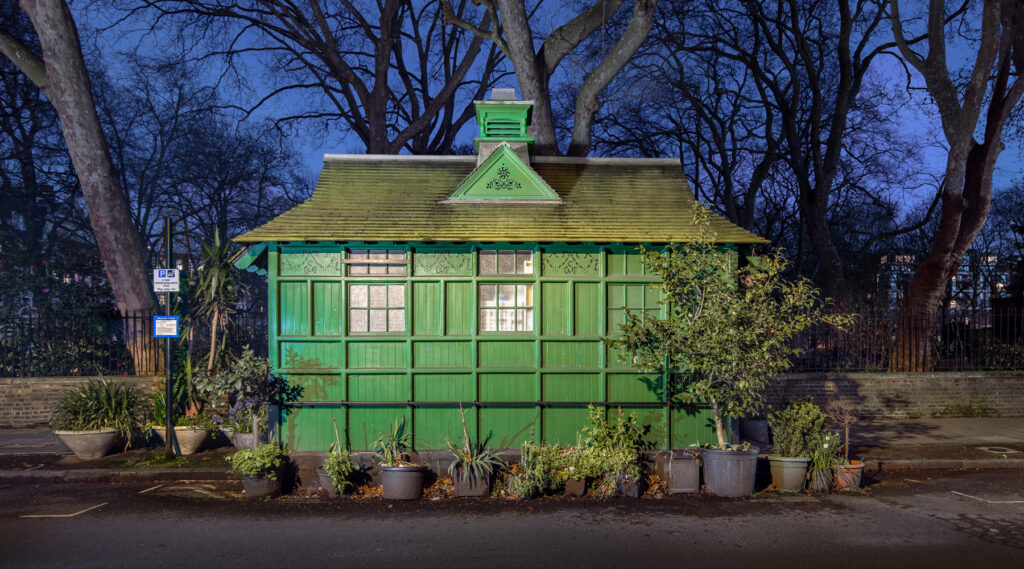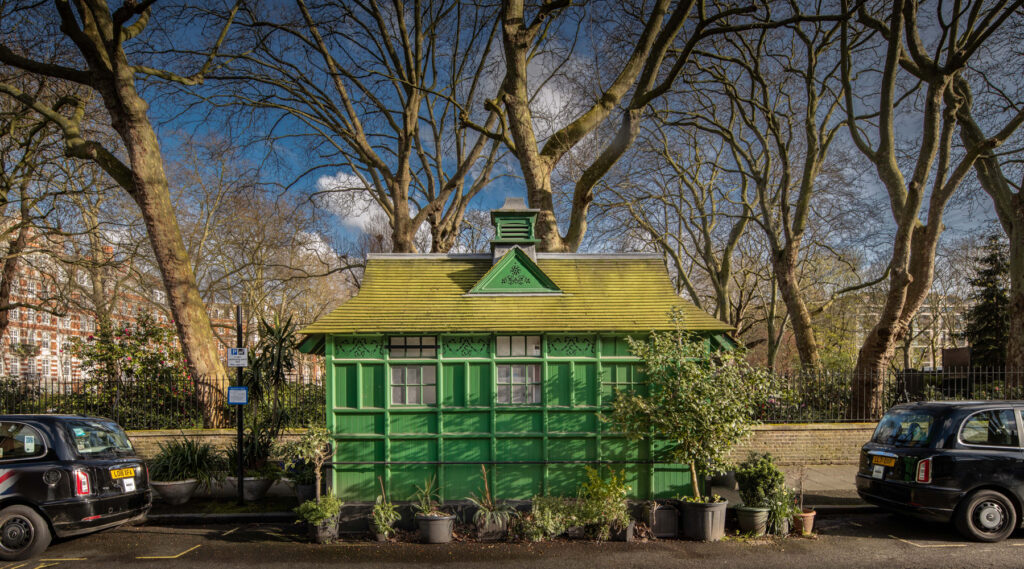There are a baker’s dozen surviving cabmen’s shelters in London, with their distinctive green shed appearance. All but one are protected from demolition. Now, the last of the thirteen — near Lord’s Cricket Ground — has been granted Grade II heritage protection from demolition.
A charity, the Cabmen’s Shelter Fund built the wooden huts as rest stops for licenced cab drivers at a time when cabs were all horse-drawn, and although horse-drawn cabs have long since passed away, the shelters still remain and still serve their original function.
They were though, a typically Victorian intervention – to stop cab drivers from drinking in pubs.
At the time, cabbies were forbidden from leaving their horse-drawn cabs unattended when on the taxi rank waiting for a customer, so if the weather was bad, many would simply “down tools” and decamp to the local pub until the weather improved.
When Captain George C Armstrong, editor of The Globe newspaper, was unable to get a cab during a storm because the drivers had all sought refuge in local pubs, he decided to band together a group of wealthy and influential philanthropists to provide a solution. He helped establish the Cabmen’s Shelter Fund in London in 1875 with the 7th Earl of Shaftesbury, providing warm and dry rest stops at ranks along many major thoroughfares across the city.
The first shelter was moveable and opened on a very foggy Saturday morning, the 6th February 1875 on Acacia Road in St John’s Wood, outside Armstrong’s home.
A very Victorian photo of that shelter is here.
The shelters had a small kitchen and space for around 10 drivers to sit and enjoy a meal and each other’s company. In keeping with rich Victorian philanthropists’ opinions about how they could improve society’s morals, gambling, drinking, and swearing were strictly forbidden in the shelters.
In the first two weeks, the first cabmen’s shelter served up the grand total of: 1,165 cups of tea, 700 slices of buttered bread, 262 chops and steaks and 27 pounds of sausages.
Within a month, seven more shelters were being built or planned, and at their peak, there was nearly 70 shelters dotted across London, although just 13 now survive.
Despite their names, although only cabbies can sit inside the surviving shelters, most serve the general public through their hatches — not unlike their modern equivalents, mobile coffee bikes that are an increasing sight in pedestrianised areas.
The distinctive green cabmen shelters are still overseen by the Cabmen’s Shelter Fund, which will celebrate its 150th anniversary next year.
The familiar size, shape and colour helped cabbies spot the shelters easily. They are all the same proportions – no bigger than a horse and cart as they were on a public highway. Designs varied over time but the most recognisable ‘ornamental’ version we see today was the work of architect Maximillian Clarke. The letters CSF for Cabmen’s Shelter Fund can often be found in the decorative fretwork. There’s even an official cabmen’s shelter paint colour – Dulux Buckingham Paradise 1 Green.
All 13 shelters were restored in a campaign by Heritage of London Trust during the 1980s and 1990s. Heritage of London Trust most recently supported the repair of ‘The Pier’ shelter on Chelsea Embankment by Albert Bridge in 2022.
Luke Jacob, Listing Adviser at Historic England, said: “Full of intrigue, history, tea and bacon sarnies, London’s well-loved cabmen’s shelters are distinctive relics of the horse-drawn age in the capital. Originally built from 1875 for the drivers of London’s Hansom cabs, they continue to serve both passers-by and cab drivers on the ranks today. As we approach the 150th anniversary of the Cabmen’s Shelter Fund it is fitting that the final shelter on Wellington Place – lucky number 13 – has received the official recognition it deserves through listing.”
13 Historic Cabmen’s Shelters in London:
- Chelsea Embankment SW3
- Embankment Place WC2
- Grosvenor Gardens SW1
- Hanover Square W1
- Kensington Park Road W11
- Kensington Road W8
- Pont Street SW1
- Russell Square WC1
- St. George’s Square SW1
- Temple Place WC2
- Thurloe Place SW7
- Warwick Avenue W9
- Wellington Place NW8









I remember one in Kensington very well, 50s/60s, always liked the style. lovely shed!
My good but now departed friend Tony Robinson used to maintain these shelters, as he was a master carpenter. He used to tell us of various work he’d had to do on them, such as repairing one that had been hit by a vehicle & moved a couple of feet down the road it was on.
There is a similar but smaller cabmen’s shed in NW3 very near the Royal Free Hospital on the main road running between Hampstead and Belsize Park tube stations. Not in the wonderful Paradise 1 Green. Black, from recall. I wonder how it fits into the Cabman’s shelter Fund and if there are any others like it?